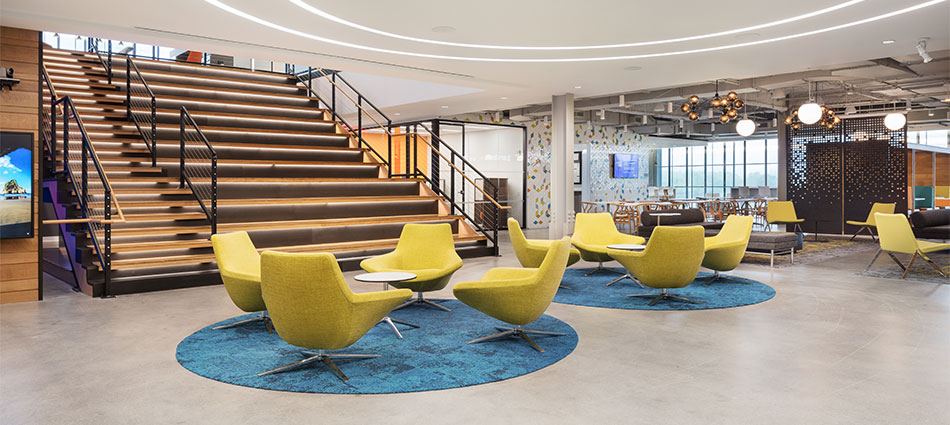When searching for office space, businesses are presented with more choices today than ever before. Workplaces around the globe continue to be more and more virtual, devaluing the need for large floor plans, and the flexible office market is flourishing which provides a comfortable middle ground.
As a result, CEOs and real estate decision makers in all industries are asking, “How does a more traditional office lease benefit my business?”
The answer lies within the tangible value it adds in helping your business recruit and retain talent.
An office is seen as an investment in your current and future employees. It speaks to a certain part of your company story. It should promote energy, inspire communication, express goals and represent your organization’s culture.
Here are four rules to follow when searching for office space that adds value to your business:
Hone in on Amenities
Look for amenities that make your employees’ lives easier and more interesting. Variety is important. Does the landlord invest in providing that sense of day-to-day diversity such as on-site events or food selection?
Observe everything around the building as well. What’s within walking distance? Is there a vibrant local community? Are the common areas Wi-Fi enabled? Is the property landscaped? Does the building appear to be in good shape?
A proactive landlord is an amenity unto itself. A good property management team who makes sure every aspect of the building is delivered fresh, clean and kept up to date can be the most valuable amenity of all. Research the companies in charge and ask their occupants about the experience they’ve had.
Make Room For Growth
Startups, please listen close. If you are going to commit 5-7 years to an office space, make sure that it provides flexibility.
First and foremost, negotiate for a Right of First Offers as well as expansion and growth rights. Consider taking an extra common area or conference space, which can always be repurposed later. Find an office building with large communal areas and atriums that can be conducive meeting spaces.
Avoid floor plans with too many walls or hallways, and note the occupancy of the building. You certainly do not want to commit to a building that has a historically high vacancy rate, but extra space isn’t necessarily a bad thing – especially if it’s adjacent to you, above you or even below you.
For similar reasons, keep your eye out for new developments in your target neighborhoods. If you find one that is perfect for your business, be among the first tenants in the building. It will give you first choice of space and being an early adopter can come with perks if leveraged properly.
Produce an Inspiring Workplace
The world of office design has changed dramatically over the last two decades. Simple design techniques can make the difference between Class A and Class C consideration. During your search, make sure each space is recently renovated or that the landlord provides you sufficient tenant improvement allowances if not a full turn-key job.
Open areas are vital, but privacy is fighting its way back into the picture. Make sure you accommodate for breakout rooms and phone booths if you are looking for an open concept. Low benching style cubicles with semi-transparent dividers can make for the best of both worlds.
When considering how to incorporate private offices, make sure they don’t impede on the flow of natural light. Glass is your friend, and so are light colors and high ceilings to help free the space of barriers. Glass can be expensive though, and there are several “glazing systems” that are more affordable than the standard full-height glass finishes you see in modern offices like that of Google and Twitter.
Kitchen areas, cafés and snack bars can serve a multitude of purposes when done correctly. They can double as meeting space and event space on top of being a place to eat and get away. Simply leaving them as an afterthought is a missed opportunity.
Consider the Commute
The millennial generation and even a large portion of Generation-X are, or will be in dual working households, so your employees time is more valuable than ever. Establish what you believe your target labor pool to be, or where the majority of your employees work, and focus on buildings convenient to areas that accommodate that research.
If you have flexibility in your location, consider things like the cost of living in local communities, and if that community provides family logistic solutions like daycare centers and after-school programs. Take a look at the school systems and where they rank. A good school system can mean many things, but among the most important is a quality labor pool.
Look for offices with mass transit options to make meetings in a large city more convenient and traffic-free. Buildings that provide shuttle service to and from mass transit stops are not only convenient, but speak volumes about the landlord. If not mass transit, make sure it is near highway access, and avoid locating yourself near a notoriously congested road. Of course, your employees will need a place to park when they get there, so make sure your building makes that as easy as possible.
There are many factors that will steer you when searching for office space. While it’s difficult to find one to meet each and every one of your needs exactly, it is ultimately up to you, as a decision maker, to define the solutions that secure the best opportunity for your employees and the company’s future.

